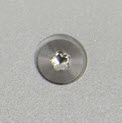Buying a new MacBook Pro 13-inch with retina display -- Don't bank on upgrading it!

Earlier this week, Apple unveiled a new MacBook Pro 13-inch complete with retina display. If you're planning on buying one of these then you'd better load up your purchase up with all the RAM and storage you'll need, because it's not the sort of machine that makes upgrading easy.
Why? An iFixit teardown shows us why.
First, you have to get past the proprietary pentalobe screws holding the device together. Good luck defeating these unless you have the right tool.

Get past these and you can access the SSD, which is tucked underneath the trackpad assembly. Seems nice and accessible, but a 9.5mm thick 2.5-inch laptop drive won't fit the space. A 7mm or 5mm super-slim drive might fit, but even these will require special -- and as yet, non-existent -- cabling to hook them to the MacBook.
If you then carry on and pull the battery pack out of the new MacBook Pro 13-inch with retina display -- do it carefully, because that sucker is glued in and can be punctured -- you will eventually make your way to the logic board. On the logic board is the RAM, but unlike most notebooks, this RAM is soldered to the logic board.
Bottom line is that however much RAM your MacBook Pro 13-inch with retina display had leaving the assembly line is all it will ever have.
The iFixit team gave the MacBook Pro 13-inch with retina display a repairability score of 2 out of 10 (where 10 is the easiest to repair). This basically means that while it works, you are OK, but when it breaks, your MacBook Pro is going to need professional -- and expensive -- TLC.
Image source: iFixit.